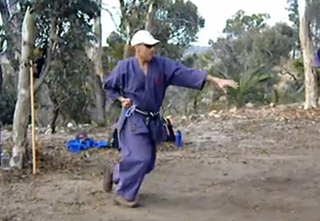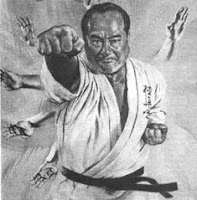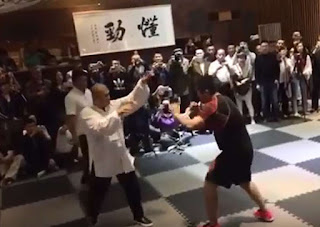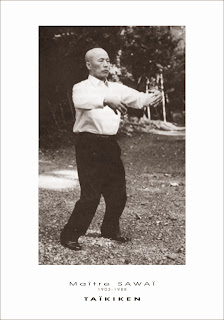Giving away the big secrets
 |
| Using body momentum should feel like you're falling into the punch |
As far as I can tell, my teacher Chen Yun Ching has always shown me everything he could in the time available. He has held nothing back. And he has issued no caveats on me passing on his knowledge either.1
The same applies to my first primary teacher, Bob Davies.
For the most part none of my teachers have kept "secrets" - even if certain (profound) information known to them is hardly known to some others. They have given me their knowledge without restriction and without fettering my own capacity to pass it on.
It is in this spirit that I wish to share details of what I regard as very important knowledge.
It is knowledge to which I've alluded in the past, namely the internal (specifically xingyiquan) method of timing a hand technique to land with a step.
Okay, I know: this might sound boring: something theoretical and clinical; something of little use in the "real world". But the truth is, when it is done correctly the method I'm about to show you feels like you're literally falling into the punch. Done optimally, it has the capacity to increase your "punching power" dramatically by the "simple" measure of adding the momentum of your step to the staged activation of your hip and arm.
I demonstrate this in the video below:
This means that you don't step first, and punch second. Your punch actually uses your step. How about that for a change! The physics of it are simple enough:
When your foot touches the ground, the falling has started to be broken. If you want to use the falling to its maximum, you must do so before your fall is broken.
Conversely, if your hand hits too much before the foot lands, you risk not having reached (and hence utilised) maximum falling momentum.
The top MMA fighters already know this, particularly ones that rely on skill in technique like Lyoto Machida - see the stills below.
I've had many responses to this over the years from karateka.
| Machida in action - note how he times his step and punch so that they land at exactly the same time - quite unlike the karate "basics" one so often sees. |
And my answer is (all too often): "Er... no, I'm afraid you don't. Certainly not from my observation of how you do your basics and kata anyway."
Many karateka have looked at my first video above and said to me: "We do those drills already!"
In fact, they've seized upon the "intermediate" lunging drills I've deliberately chosen because they will be familiar to karateka and can serve as a kind of springboard to understand the broader concept. But these "intermediate drills" are not the end goal: they don't deal completely with the momentum transfer concept to which I'm referring. Rather, I'm referring to other movement, such as full stepping (where the legs pass - see Machida on the left). And, sadly, the Machida example is not how many (most?) karateka tend to practise these sorts of stepping punches.
Let's be honest here: such steps are always taught in karate kihon/kata as "step first, then punch". Why? I believe it was initially to break things down for beginners. Beginners don't want or need a multitude of things to think about when they are still trying to sort out gross motor learning. They want to focus on one thing at a time. That is how it should be. For beginners anyway.
Unfortunately, karate as an art seems to have suffered greatly from attempts to popularise it from the 1930s onwards. The most obvious consequence of this has been that the method of teaching karate appears to be stuck in the "beginner phase".
I know many karateka who don't seem to be aware of this issue at all. Others might know this in general terms, but haven't really grasped it on a detailed technical level; they can't actually point to a distinct example other than something general like: "We don't do enough bunkai (applications)".
Divorcing stepping momentum from a punch is a classic example if this "popularisation simplification" (what is really dilution). Yet many (even senior) karateka I know haven't even given this a moment's thought. Sadly, many won't give it a second thought even after reading this essay.
 |
| Note how the karateka executes a standard step, then punch. When his foot lands (middle frame) his punch is only halfway to its target (see the video). The foot/hand disparity is typically even greater when executing a reverse punch. |
But this is actually not my experience in teaching step timing - even when teaching highly experienced karateka.
It is worth noting that I was once part of a xingyi class comprising 3rd-6th dan karateka, each with decades of experience. Despite endless drilling by Master Chen, none of us (except, of course, our senior, James) could time the punch to land with the step on demand. For years our dear teacher would simply put his head in his hands despondently while watching us perform.
 |
| I felt I finally started getting somewhere with xingyi stepping in 2007. Here I'm half-way through a step, about to time my right fist with my left foot. |
I know that some in that original class still haven't got to this level. I say this without any implied criticism. It's hard to do. Especially for karateka. They default to step, then punch, especially under pressure. The sequence is too deeply ingrained. It helped me that I had years of internal training under my former teacher, Bob Davies.
All this has made me examine, very closely, the whole issue of how to teach the vital skill of correct step/punch timing. I have concluded that, before anything else, it is critical that you understand the following:
- the importance of optimal timing of hand techniques with stepping - specifically so that they land at exactly the same moment; and
- the importance of understanding that you, as a karateka, taekwondo practitioner or practitioner of most other "external" arts (and even internal arts) probably can't do it - at least properly; its hard!
What is this "intermediate phase"? Well the previous video gives some clue. It is my attempt on our recent gashuku (training camp) to give a graduated approach to learning exactly how to develop the timing of which I speak - starting with drills that are intuitive to karateka, then building on these in a progressive, systematic way.
It is my ultimate intention that these drills should culminate in the constituent elements of the hybrid forms I have designed. In that way, practitioners have a neat, comprehensive "packaged" summary to practice these "stem cell" concepts. In my view that is, after all, the function all kata were intended to serve: a kind of mnemonic of necessary motor learning in a solo format.
So in the above video I start with some rather basic drills. I won't elaborate on this here in text. I'll let you watch the video (which you should do: truth be told, the text of this essay is largely dispensible - the videos are what really count!).
I then build on these drills, creating more advanced ones like those shown in the video below:
Of course, most karateka (indeed most martial artists!) are often focused almost entirely on "striking power".2 That is understandable. But you need at least some force underpinning your other techniques too - including defensive/setup ones.
So my third video below goes into more sophisticated timing drills involving "blocks" and counters in combination with both evasion and entry. It is only here that we start to get into the territory of the "building blocks" of the "hybrid forms".
This whole area of analysis was the major theme of our recent gashuku. As always, only a fraction was videoed. I'll almost certainly be expanding on this theme in future videos and articles, but for now, this will have to suffice.
In the meantime, I hope you accept on the basis of my preceding videos and argument that it is entirely possible for a karateka to "liberate" his or her art from the shackles of "fragmentation"; to maximise momentum transfer gained from flow; to go beyond the basic "one-two" paradigm that is appropriate for beginners but is manifestly inappropriate for anyone beyond the beginner phase. I hope you accept that it is possible for the karateka to do so without having to learn an entirely new, alien, paradigm of basic techniques (eg. the internal arts). The basics in one's chosen art should suffice, leaving you to learn an art like taiji, bagua or xingyi only if they interest you particularly.
But does all this "punching and stepping" matter? Really?
I say it does! What I'm talking about isn't just an illusion. If you want real "power", you must use your body weight, and you must do so optimally. And this isn't just for full stepping with a reverse punch (like Machida): it is for a whole host of other techniques.
Consider the throw in the following video as just one example. There are many other techniques from the internal arts that rely on this sort of control over how you transfer your momentum. An inability to do a reverse punch timed with a full step just reveals a "hole" in vital motor learning relevant to advanced martial arts techniques.
So no, you can't just rely your hip (or the dreaded "double hip", which is really the antithesis of whole body momentum use) to "power" your techniques.You have to recognise that fighting of any kind is a dynamic activity: it happens in the context of constant movement, including lunging and stepping. It might well feature a "standing start" - but it hardly ever stays that way (unless it is a "one punch" affair). If it progresses beyond "standing start" you need "power" - and you need to have it in movement.
Consider the throw in the following video as just one example. There are many other techniques from the internal arts that rely on this sort of control over how you transfer your momentum. An inability to do a reverse punch timed with a full step just reveals a "hole" in vital motor learning relevant to advanced martial arts techniques.
So no, you can't just rely your hip (or the dreaded "double hip", which is really the antithesis of whole body momentum use) to "power" your techniques.You have to recognise that fighting of any kind is a dynamic activity: it happens in the context of constant movement, including lunging and stepping. It might well feature a "standing start" - but it hardly ever stays that way (unless it is a "one punch" affair). If it progresses beyond "standing start" you need "power" - and you need to have it in movement.
Don't believe me? Well take a look at this video of makiwara punching. It utilises exactly this concept of timing. Watch it and tell me it isn't powerful:
Still don't believe me? Well take a look at this next video of Machida in MMA. Heck, look at any top fighter in MMA and tell me they aren't landing their punches as they step (see my earlier sequence of photos above). Contrast this with the basic karate triple punching you see at the start of the video below (which punching approximates the techniques applied in the ring, but without any of the stepping momentum).
"Ah," you might say, "but surely the people in the above two videos don't do your type of training?"
They might not. They might well have worked this out on their own. They might just "do" it naturally. But that doesn't mean there isn't a science behind it - and that it is useful to have a system of training built on understanding that science.
There's a good reason why there are so few people who, despite having a rather unremarkable body weight, can hit that hard. They have a certain knowledge: knowledge that levels the playing field; knowledge that gives them an edge.
Yes, you can take your chances by trying to "just do it". You can just try to hit the makiwara "real hard". You can climb into the cage and just start punching like crazy. You can try to "reinvent the wheel", disregarding development over countless generations; development that occurred in eras when these techniques were used, indeed relied upon, far more regularly than in today's alternately "high tech" and comparatively peaceful Western world. But you'll be no better than the hack golfer or tennis player who refuses to take coaching lessons in proper technique. You'll be wasting a whole lot of time.
On the other hand you can look to an immense and rich body of traditional knowledge - a time-tested, scientifically solid, hand-to-hand fighting technology based on at least a millennium of uninterrupted evolution in China and the rest of the Far East.
 |
| With Master Chen at the bai shi ceremony in 2009 |
This is knowledge of the kind passed, without restriction, to me by my teachers. The most recent of these has been my beloved Master Chen Yun Ching. He has given me the gift of just some of the encyclopedic knowledge of his (Western science-trained and impressively gifted and knowledgeable) father, the late, great Chen Pan Ling: a man who compiled (in a highly systematic and scientific way), and preserved from annihilation, this knowledge in the advance of the Japanese and later Communists.
In the same spirit, I will pass on what knowledge I have acquired from these sources - not just to my students, but freely here, on this public blog. I will continue to do so even though most of my readers are not students of mine in any direct or even indirect sense; even though I have no obligation whatsoever to do so. Even though I don't "profit" in any monetary sense from doing so. Why?
The better question is: "Why not?" Useful, scientific knowledge built on the efforts of past generations is not something to be guarded jealously. It is not something that should die and have to be reinvented. This would simply be a tragic waste. As Spock would say: it would be illogical.
 |
| Wang Shujin: note his momentum flow is visible even in a still photograph. |
If I needed a reason to share such knowledge, I could refer to the oath gave at my bai shi ceremony: a solemn oath to preserve and disseminate the knowledge collated by Chen Pan Ling so it would not be wasted. Of course, I don't need that moral imperative. For me, logic alone suffices.
So you can take what I offer, or you can leave it.
Perhaps what I've said here today is something you already know. If so, that's good. Perhaps you might disregard it while clinging instead to some other "arcane detail" that I regard as either wrong, obvious, banal or simply of no real import in the broader scheme of things. Perhaps you might disregard it as "some theoretical claptrap from a traditional martial artist". If so, then that is your prerogative.3
However my hope is that what I've freely given here is of some real use to you - as much use as it has been to me in understanding, and improving, my own martial arts performance. In other words, I hope that my sincere and diligent efforts in sharing have not been wasted. That is as much as anyone can hope for.
Footnotes:
- I say this knowing that there are a few small exceptions: some applications that my teachers don't show except to select people because the applications are particularly nasty and my teachers don't feel comfortable showing them to just anyone. My students will know what I mean when I mention, for example, particular details of eye gouging that I won't share online.
- I find it ironic that people like one former regular troll would write rambling, incoherent novellas on this blog, urging me to consider the "superior" methods of attack contained in some modern "target focused" systems that are based principally on drills that depend on little more than "slick marketing of someone submitting to being a punching bag while someone else pretends to hit them" (see Footnotes 5 and 6 in this article). I have yet to see in these "systems" any scientific approach to momentum maximisaiton of the kind I discuss in this article. How ironic that I should be continually directed to such persons so that they can teach me "how to attack properly/better" (ie. how to suck eggs).
- My suggestion is that before you make up your mind, give my "punching as you land" an honest go - using the drills I've demonstrated. Once you feel some "power", try it on a makiwara. Don't take my word for it and don't just assume that I'm "wrong" because it's not how you were taught or not what you've believed for "x years". And don't give up just because, like most folks I have taught, you don't get the timing just right initially.



Comments
Post a Comment